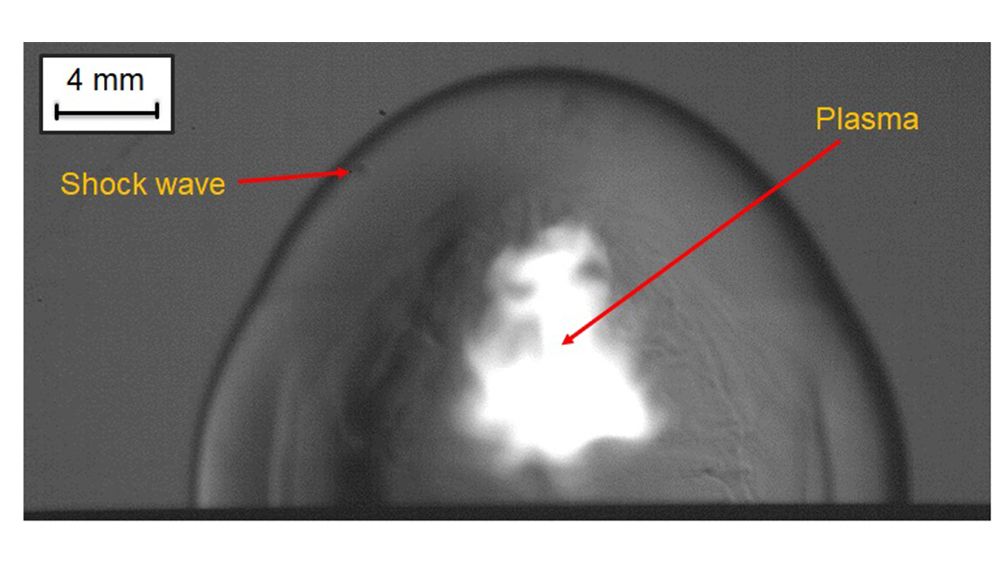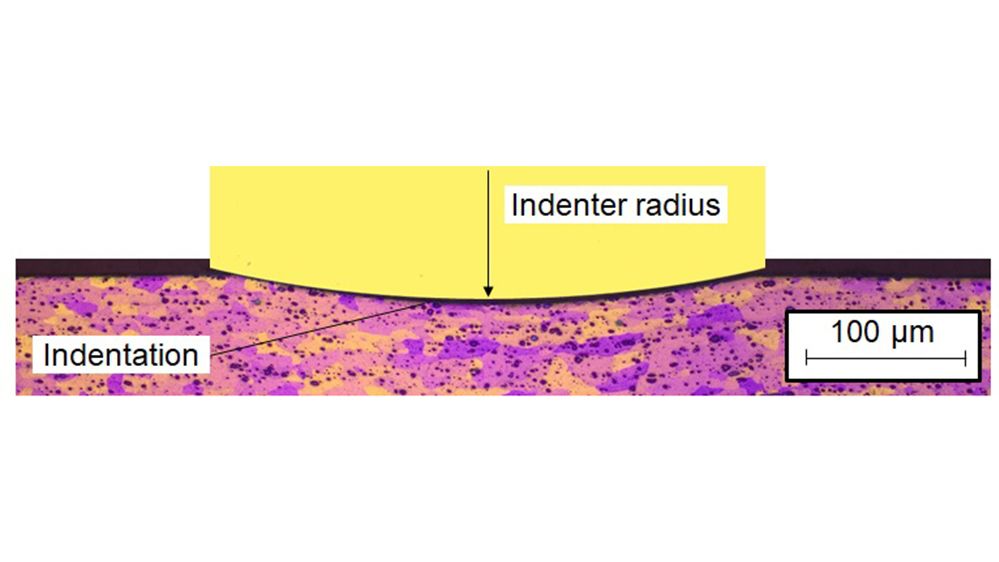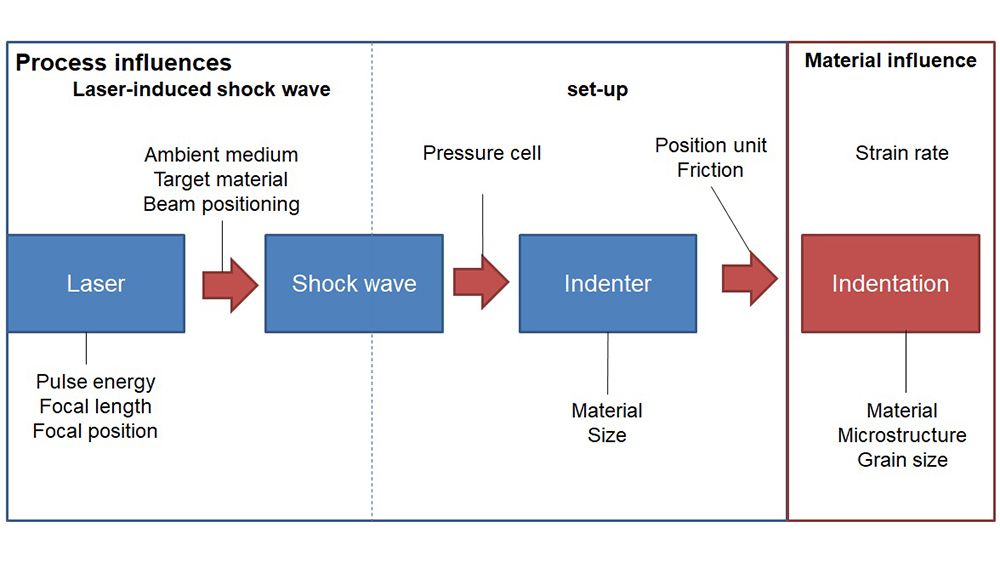D02 - Laser-Hardness
D02 - High-speed hardness measurements of metallic materials
Conventional testing methods are based on time- and resource-intensive investigations of a wide range of material properties. A frequently used test method is the hardness measurement. Hardness test methods can be used to determine the indentation resistance of a material. Standardized test specimens are pushed into the material under a defined force. Subsequently, the resulting indentation area or depth is measured. In order to meet the requirements of an efficient identification of new materials and compositions, a novel high-speed hardness testing method based on laser-induced shock waves is investigated within the SFB 1232 "Farbige Zustände" in the subproject "Laser Hardness". This method is to enable a hardness measurement consisting of test, measurement and evaluation time of less than one second.
In contrast to conventional measuring methods, a TEA CO2 laser is used to generate a shock wave (see Figure 1) above a test specimen, causing it to be pushed into a material surface by impulse transfer (see Figure 2). The propagation of the shock wave can be made visible by the Schlieren method.
Laser systems offer the possibility to achieve high-throughput in the micro range because they are highly dynamic and flexible. The central question of the sub-project is therefore to gain a profound understanding of laser shock processes in order to make them usable as measuring methods.


The starting point of the investigation was the determination of a suitable indenter geometry. For this purpose, an indenter shape had to be identified, which could be positioned and guided easily. In addition, the laser-induced shock wave had to transmit an impulse as high as possible to the indenter. Subsequently, those process parameters were determined which have the greatest influence on the indentation reproducibility (see Figure 3). By investigating different materials, surface targets, the surrounding medium, the positioning tolerances and the surface condition, the elementary component of the subproject - the realization of a high reproducibility of the measuring method - could be achieved.

As a descriptor determining method, the sub-project is closely linked to other subprojects of the SFB 1232. The data of the measurements carried out are delivered to the respective sub-projects as early as possible. The correlations between the descriptor and the material properties were identified with the sub-project P02 and U03. The main descriptors, which showed the strongest correlations with the investigated material properties (hardness and tensile strength) are the indentation depth, the indentation diameter and the normalized pile-up height. In cooperation with the sub-project U04, the mechanism of the formation of the hardness indentation is further investigated.
Further, the goal of the project is to establish the measuring method as an automatically performed high-throughput method in the further phases. For this purpose, a dynamic overall system is to be developed, with which the indenter movement during the indentation can be measured in-situ (see Figure 4). From this, information about the elastic-plastic material behaviour can be obtained. On the other hand, the force-displacement curve can be derived from time series of the indenter movement and the application of force. This should allow conclusions to be drawn about other suitable descriptors and thus about mechanical material properties.
Publications
T. Czotscher, A. von Hehl, T. Radel, A. Toenjes: Correlation between shock wave-induced indentations and tensile strength, Procedia Manufacturing 47 (2020), 756-760
H. Fenske, T. Czotscher: Tailoring the Pressure Profile of TEA-CO2 Laser-Induced Shock Waves for Mechanical Forming and Separation Processes. Lasers Manuf. Mater. Process. (2019). https://doi.org/10.1007/s40516-019-00105-y
Steinbacher M, Alexe G, Baune M, Bobrov I, Bösing I, Clausen B, Czotscher T, Riemer O, Sonnenberg H, Thomann A, Toenjes A, Vollertsen F, Wielki N, Ellendt N (2019) Descriptors for High Throughput in Structural Materials Development. High-throughput 8:2–27 https://doi.org/10.3390/ht8040022
T. Czotscher, D. Otero Baguer, F. Vollertsen, I. Piotrowska-Kurczewski, P. Maaß: Connection between shock wave induced indentations and hardness by means of neural networks. AIP Conf Proc 2113 (2019) 1–6 . [Link to PDF]
T. Czotscher, N. Wielki, K. Vetter, F. Vollertsen, D. Meyer: Rapid Material Characterisation of Deep-alloyed Steels by Shock Wave Based Indentation Technique and Deep Rolling. Nanomanufacturing and Metrology (2019). [Link to PDF]
T. Czotscher: Material Characterisation by New Indentation Technique Based on Laser-Induced Shockwaves, Lasers in Manufacturing and Materials Processing (2018) 1-19 (online). [Link to PDF]
T. Czotscher: Analysis of TEA-CO2-laser induced plasma to establish a new measurement technique, Journal of Laser Applications 30, 3 (2018) 032604-1-5. [Link to PDF]
C. Mittelstädt, N. Blanke, T. Czotscher, H. Freiße, C. Halisch, V. Schultz, A. Simic, A. Stephen, D. Tyralla, K. Vetter, R.B. Bergmann: Aktuelle Forschungsthemen zum Laserstrahleinsatz, Schweißen und Schneiden 70, 9 (2018) 650-657. [Link to Beitrag]
T. Czotscher: Umformen, Fügen, Schneiden und Messen mit nur einem Laser - die abtragsfreie Laserschockbearbeitung, Laser Magazin 4 (2017) 6-8. [Link to PDF]
T. Czotscher, S. Veenaas, F. Vollertsen: Possibilites to characterise laser induced shockwaves, Journal for Technology of Plasticity 42, 1 (2017) 1-7.
T. Czotscher, T. Wünderlich: Energy of Laser Induced Shockwaves, Proc. of the 5th Intern. Conf. on New Forming Technology (ICNFT 2018 ) MATEC Web of Conferences 190, 02006 (2018). [Link to PDF]
T. Czotscher, F. Vollertsen: Plasma Induced On Indenter Balls, Proc. of the 8th International Conference on High Speed Forming, Columbus OH/USA (ICHSF 2018). [Link to PDF]
T. Czotscher: Influence of focal position on laser-induced plasma and hardness indentations, Proc. of the 36th Intern. Congress on Applications of Laser & Electro-Optics (ICALEO 2017) Atlanta GA USA (2017) paper no. M903. [Link zur Konferenz]
T. Czotscher, F. Vollertsen: Process stability of laser induced plasma for hardness measurements Lasers in Manufacturing (LIM17) eds.: L. Overmeyer, U. Reisgen, A. Ostendorf, M. Schmidt (2017). [Link to PDF]
Head
Prof.Dr.-Ing. Frank Vollertsen
info-mbsprotect me ?!biasprotect me ?!.de
Project Management
Tobias Czotscher
czotscherprotect me ?!biasprotect me ?!.de

![[Translate to English:] Zur Startseite des SFB Farbige Zustände](/fileadmin/user_upload/sites/sfb1232/Logos_und_Bilder/SFB1232-quer.png)
